How did innovations in agriculture impact the economy in America?
Improvements in agriculture have been one of the most dramatic features of economic and social change in America since 1800. At the start of the 19th century, over 90 percent of the population was engaged in producing the food and fiber needed to feed and clothe the nation. Two centuries later, that number has dropped to less than two percent, and American agriculture surpluses account for billions of dollars in exports.
Three Industrial Revolutions
Agricultural historians sometimes categorize these changes as coming in three revolutions. The first was the impact of the Industrial Revolution in the mid-1800s, when horse-powered machines began to supplement human energy. John Deere’s invention of a steel plow that scoured the sticky prairie sod from the blade made turning prairie sod much faster and easier. That was rapidly followed by the adoption of horse-drawn reapers, sulky plows, mowers and threshing machines that enabled one farmer to cultivate and harvest much larger holdings.
A second wave began around World War I, when gasoline power began to replace the horse. In the 1890s, Iowan John Froelich developed and improved an internal-combustion "traction motor," the tractor as it came to be known, that ran on gasoline and could move forward and backward. Over the next 20 years, Froelich continued to improve his tractors, forming a company that eventually sold out to John Deere Manufacturing in Waterloo. Henry Wallace combined his skills as corn breeder, agriculture journal editor and businessman (and future secretary of agriculture and U.S. vice president) to Pioneer Hi-Bred Corn Company. Midwestern farmers saw corn yields skyrocket when they planted the improved hybrid varieties. After World War II, chemical fertilizers, herbicides and pesticides, often developed from research at land grant universities like Iowa State, further boosted farm production.
In the 1960s, a truly new stage in agriculture began to emerge. Throughout history until then, from indigenous people around the world to the most advanced agriculture operations, the goal had been to improve the growing conditions around the individual plant. Remove the weeds, fertilize the ground and water the plants. With new genetic breakthroughs, however, scientists were developing the capacity to go "inside" the plant to reconfigure its genetic codes that guided its growth. Genetically-modified plants sparked a controversy because their long-term environmental impact had never been tested. The livestock industry engaged in new breeding techniques to adapt animals to their environment and to market demands.
Effects on Rural Population
All three stages of Midwestern agriculture had decisive impacts on the rural population. Labor-saving equipment reduced the need for hired help and led to an incentive to farmers to expand their acres. As farms grew larger with less hired help, the rural population decreased, putting a stress on the small towns and rural institutions like churches, hospitals and schools. Rural representation in the legislature diminished. Conflicts developed between those who wanted the government to support small farmers while others preferred to allow the market economy, usually favoring larger, better funded operations, to determine prices. While the outputs of American farms multiplied exponentially, the social impacts created both positive and negative outcomes for farm families and the rural populations that depended upon them.
Supporting Questions
What effect did innovations like the plow have on agricultural production?
- "Wakefield’s Hand Corn Planter" Newspaper Article, 1855 (Document)
- Baker's Plowing Machine Advertisement, 1862 (Document)
- "The Farm and Garden," Newspaper Article, February 12, 1872 (Document)
- "Valuable Invention!" Advertisement, 1885 (Document)
What role did agriculture innovation play in the settlement of the West?
- Diploma Awarded by the People's Agricultural Society of West Jersey, between 1857 and 1867 (Image)
- "Lagonda Agricultural Works" Print from Clark County, Ohio, 1859 (Image)
- "McCormick's Reaper-Works" Newspaper Article, October 9, 1874 (Document)
How did innovations in agriculture meet the needs of farmers and their communities?
- "History of Scott County, Iowa. Chapter IV (pt. 4)" Essay from The Annals of Iowa, 1863 (Document)
- "A Sulky and Gang Plow" Newspaper Article, September 16, 1874 (Document)
- "Machinery Department" Newspaper Article, August 27, 1897 (Document)
| Innovation in Agriculture Source Set Teaching Guide |
| Printable Image and Document Guide |
"Wakefield’s Hand Corn Planter" Newspaper Article, 1855
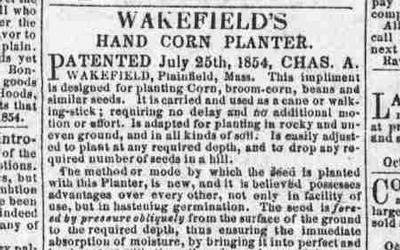
Description
This article appeared in an Ohio newspaper in 1855. It touted the significance of the new Wakefield Corn Planter. The article describes how the planter works and why it is an improvement over other methods of corn planting, and it ends with numerous testimonials from…
Baker's Plowing Machine Advertisement, 1862
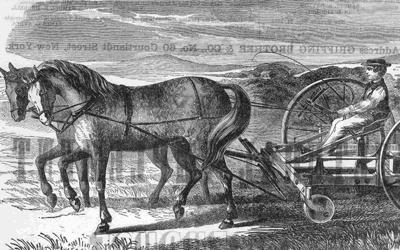
Description
This document is an advertisement for a double-plowing machine, and it includes an image of the new plow being drawn by a team of horses. The advertisement, from 1862, contains testimonials from farmers to confirm the claims made by the manufacturer.
"The Farm and Garden," Newspaper Article, February 12, 1872
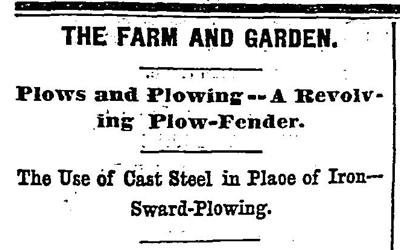
Description
This article appeared in the Chicago Tribune in 1872 on the "Farm and Garden" page. The author gives advice to farmers about new plows and spends a great amount of time advocating for cast steel in the manufacturing process. The author states that the volume…
"Valuable Invention!" Advertisement, 1885
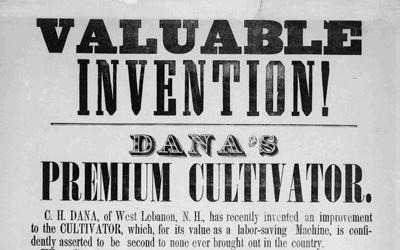
Description
This 1855 advertisement has two parts. The first part by the manufacturer makes claims about their new cultivator, while the second half contains testimonials from farmers confirming the claims. The claims about the device make the point that it is a time-saving device that…
Diploma Awarded by the People's Agricultural Society of West Jersey, between 1857 and 1867
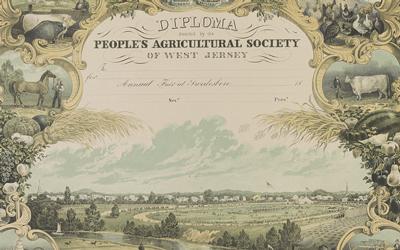
Description
This print shows a bird's-eye view of fairgrounds with a steamboat on the river in the foreground. The image includes seven vignettes showing livestock, agricultural machinery, and, at top center, two female figures representing "Liberty and Prosperity." Also shown on…
"Lagonda Agricultural Works" Print from Clark County, Ohio, 1859
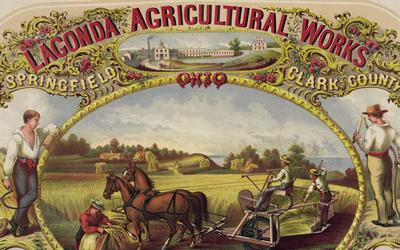
Description
The scenes on this print show men harvesting grain using mechanical devices. The print, originally produced in 1859, was published in the book, Eyes of the Nation: A Visual History of the United States, in 1997.
"McCormick's Reaper-Works" Newspaper Article, October 9, 1874
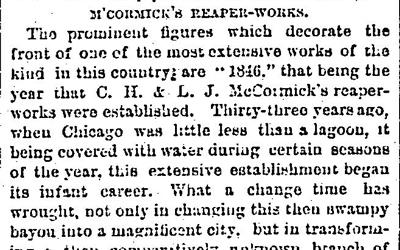
Description
This newspaper article appeared in the Chicago Daily Tribune on October 9, 1874. It describes McCormick reapers and other innovations by C.H. & L.J. McCormick. The author credits the McCormick Reaper-Works with helping to improve farm implements as well as…
"History of Scott County, Iowa. Chapter IV (pt. 4)" Essay from The Annals of Iowa, 1863
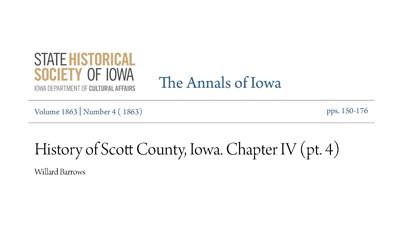
Description
The Annals of Iowa published a history of Scott County in 1863. Among the details was the story of the "Agricultural Society," which sponsored a fair in the county starting in 1854. The essay shows that the fair expanded every year as it became…
"A Sulky and Gang Plow" Newspaper Article, September 16, 1874
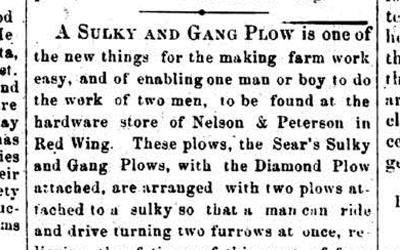
Description
This newspaper article appeared in The Grange Advance in Red Wing, Minnesota, in 1874. It makes the point that a Sulky and Gang Plow will make the work of farmers easier. The article promises that the plow, made by Sear's, will ease the difficulty of farm…
"Machinery Department" Newspaper Article, August 27, 1897

Description
This newspaper article from 1897 talks about the importance of the Iowa State Fair to farmers in the state. The piece focuses on the new implements farmers can see and the salesmen they can discuss the new tools with at the fair. The author boldly claims that…
Additional Resource
-
The Goldfinch: Early Agriculture (Vol. 2, No. 3, February 1981)
This Iowa history magazine for children was published quarterly by the State Historical Society of Iowa from 1975-2000. Each issue focuses on different people, innovations and farming techniques that were all part of Iowa's early agricultural practices.
Iowa Core Social Studies Standards (8th Grade)
Listed below are the Iowa Core Social Studies content anchor standards that are best reflected in this source set. The content standards applied to this set are high school-age level and encompass the key disciplines that make up social studies for eighth-grade students.
| No. | Standard Description |
| SS.8.16. | Analyze the role of innovation and entrepreneurship in institutions throughout early American history in a market economy. |
| SS.8.17. | Use historical evidence to evaluate the state of regional economies throughout early American history. |
| SS.8.18. | Explain how the physical and human characteristics of places and regions influence culture. |